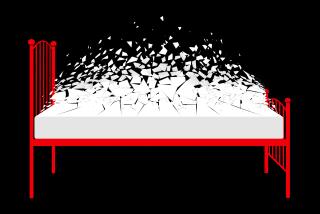‘Information Label’ to Advise Consumers on How to Ward Off New-Carpet Fumes
- Share via
ATLANTA — Besieged by complaints that fumes from new carpet make people sick, a leading industry group said Tuesday that it is preparing a label to tell consumers how to protect themselves.
However, at the same time it is suggesting that carpet makers use the label, the Carpet and Rug Institute is not acknowledging that any carpet is unsafe.
“This is not a warning label, because there is nothing to warn,” said Ron VanGelderen, president of the group, which represents manufacturers of 95% of the carpet made in the United States. “This is a consumer information label that fits into a continuing program of consumer information.”
News that the label was being prepared was first reported Tuesday in the the News & Observer of Raleigh, N.C. About 70% of the nation’s carpet is made in northern Georgia.
While the label’s wording has not been finalized, it will probably emphasize “common sense” tips such as opening windows to improve ventilation for about three days after installing carpet, the institute said.
The federal Consumer Products Safety Commission has received hundreds of complaints of respiratory and nervous ailments blamed on carpet.
They include flu-like symptoms such as weakness, achy joints and congestion. Some people report more serious problems, such as nosebleeds and dementia. Critics fear that carpet fumes could be especially harmful to toddlers who spend hours playing on the floor.
A number of state attorneys general have also criticized the industry, and a class-action lawsuit accusing three Georgia carpet manufacturers of concealing health risks is pending in Philadelphia federal court.
*
Among the more vocal critics of the industry is Rep. Bernard Sanders, an independent from Vermont. The label is being prepared in conjunction with his office, and a Sanders aide praised the industry group Tuesday for voluntarily agreeing to write it.
“Last year, we tried to work on the issue on two fronts--to get the EPA and Consumer Products Safety Commission involved,” said Debbie Bookchin, a Sanders spokeswoman.
“The nice thing is, though the government has been kind of slow, we’re finally working with the carpet industry to respond,” she said.
Bookchin said she understands the label will acknowledge that “there can be, under circumstances, times when individuals will experience adverse reactions to new carpet.”
Last year, the carpet industry tried a different labeling program, showing that carpets had passed a test to ensure that certain chemicals--byproducts of the manufacturing process--were within an industry-set safety level.
But critics, including Sanders, said the so-called Green Tag program falsely assured consumers that carpet is safe.
*
Sanders has based much of his criticism on tests conducted by Anderson Laboratories of Boston, which found that several mice died and others had seizures after breathing warm air blown over carpet samples that had made humans sick. The EPA has been unable to replicate the findings, however, and the carpet industry has dismissed the Anderson results.
“However, we are aware that the public . . . is somewhat concerned by recent news media reports about flawed scientific experiments,” VanGelderen said.
Reg Burnett, a carpet industry consultant in Dalton, Ga., said he believes the proposed labeling is in response to political, rather than safety, concerns.
“If you put carpet in every home, you would probably have .0001% who are allergic to carpet, as they are to other things,” he said. “That doesn’t make carpet a dangerous product, but now you’ve got a politician waving a flag and saying it’s a problem.”
Bookchin said the labels are just a first step toward addressing health concerns. “We still feel there’s plenty of work to be done, and we look forward to doing more research to determine exactly what chemicals are causing the health hazards and eliminating them from the carpet,” she said.
More to Read
Inside the business of entertainment
The Wide Shot brings you news, analysis and insights on everything from streaming wars to production — and what it all means for the future.
You may occasionally receive promotional content from the Los Angeles Times.








